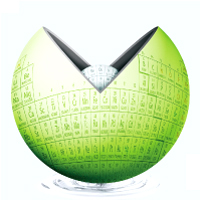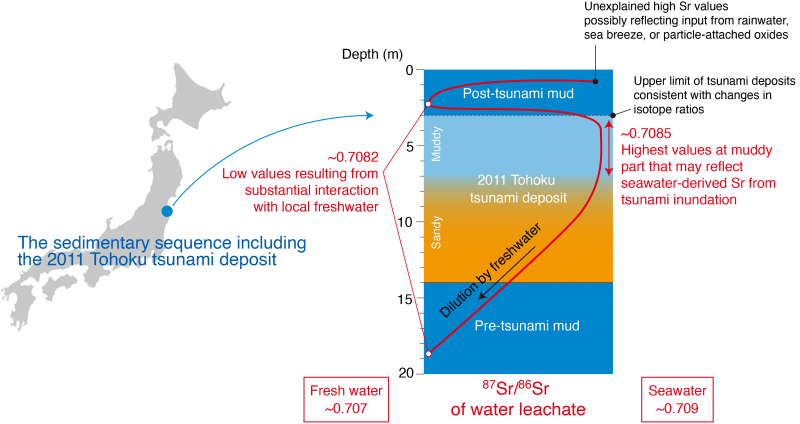
The Sr isotope ratio of sediment leachate: a potential indicator of tsunami inundation
ABSTRACT

Detecting seawater-derived elements in terrestrial sediments as evidence of tsunami inundation is challenging due to dilution by freshwater over time. This study provides data useful for evaluating the potential of the strontium (Sr) isotope ratios (⁸⁷Sr/⁸⁶Sr) as indicators of seawater intrusion. We analyzed ⁸⁷Sr/⁸⁶Sr ratios in water leachates and acetic acid (AcOH) leachates from a sedimentary sequence sampled in November 2015 from a coastal lowland in Tohoku, Japan, which includes deposits from the March 2011 Tohoku earthquake tsunami. The ⁸⁷Sr/⁸⁶Sr values of water leachates were low (~0.7082) in the pre-tsunami muddy layer, close to local freshwater values (0.7069), but higher (~0.7085) in the upper muddy part of the tsunami deposit, approaching seawater values (0.7092). This suggests that the muddy part retained seawater-derived Sr due to its low permeability and high cation adsorption capacity of clay minerals. However, alternative sources of high Sr isotope ratios, such as rainwater, atmospheric deposition, and acid-leachable materials, must be considered. If the high values reflect seawater intrusion, Sr isotope ratios provide a distinct advantage over element concentrations as tsunami indicators due to their longer retention, detectable even four years after the event. In contrast, AcOH leachates exhibited significantly higher Sr isotope ratios (>0.7095) throughout the sequence, perhaps reflecting contributions from less-soluble components, such as oxides and clay minerals, in addition to marine carbonates. This finding suggests that AcOH leaching is unsuitable for isolating seawater-derived Sr.
KEYWORDS
Keywords: 2011 Tohoku earthquake tsunami, tsunami deposits, muddy sediments, adsorption, 87Sr/86Sr- Published : 2025
- Released on J-STAGE : -
- Received : 2025/07/02
- Accepted : 2025/09/15
- DOI : https://doi.org/10.2343/geochemj.GJ25015
- J-STAGE URL : https://www.jstage.jst.go.jp/article/geochemj/advpub/0/advpub_GJ25015/_article/-char/en
- J-Online ISSN: 1880-5973
- Print ISSN : 0016-7002
- ISSN-L : 0016-7002
All Issues
- Vol.59, 2025
- Vol.58, 2024
- Vol.57, 2023
- Vol.56, 2022
- Vol.55, 2021
- Vol.54, 2020
- Vol.53, 2019
- Vol.52, 2018
- Vol.51, 2017
- Vol.50, 2016
- Vol.49, 2015
- Vol.48, 2014
- Vol.47, 2013
- Vol.46, 2012
- Vol.45, 2011
- Vol.44, 2010
- Vol.43, 2009
- Vol.42, 2008
- Vol.41, 2007
- Vol.40, 2006
- Vol.39, 2005
- Vol.38, 2004
- Vol.37, 2003
- Vol.36, 2002
- Vol.35, 2001
- Vol.34, 2000
- Vol.33, 1999
- Vol.32, 1998
- Vol.31, 1997
- Vol.30, 1996
- Vol.29, 1995
- Vol.28, 1994
- Vol.27, 1993
- Vol.26, 1992
- Vol.25, 1991
- Vol.24, 1990
- Vol.23, 1989
- Vol.22, 1988
- Vol.21, 1987
- Vol.20, 1986
- Vol.19, 1985-1986
- Vol.18, 1984
- Vol.17, 1983
- Vol.16, 1982
- Vol.15, 1981
- Vol.14, 1980
- Vol.13, 1979
- Vol.12, 1978
- Vol.11, 1977
- Vol.10, 1976
- Vol.9, 1975
- Vol.8, 1974
- Vol.7, 1973
- Vol.6, 1972-1973
- Vol.5, 1971
- Vol.4, 1970-1971
- Vol.3, 1969-1970
- Vol.2, 1968
- Vol.1, 1966-1967




